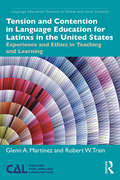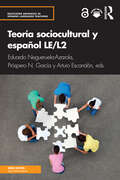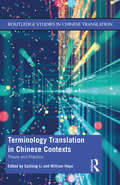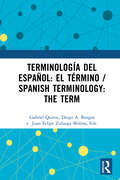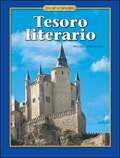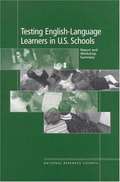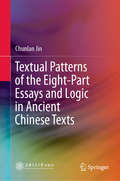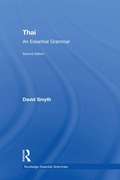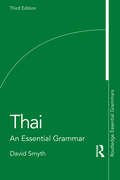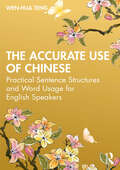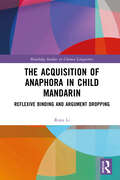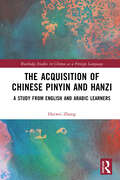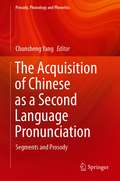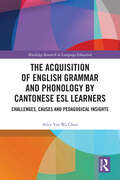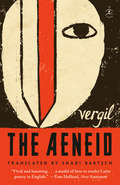- Table View
- List View
Tension and Contention in Language Education for Latinxs in the United States: Experience and Ethics in Teaching and Learning (Language Education Tensions in Global and Local Contexts)
by Glenn A. Martínez Robert W. TrainApplying a critical lens to language education, this book explores the tensions that Latinx students face in relation to their identities, social and institutional settings, and other external factors. Across diverse contexts, these students confront complex debates and contestable affirmations that intersect with their lived experiences and social histories. Martinez and Train highlight the pedagogic and ethical urgency of teacher responsibility, learner agency and social justice in critically addressing the consequences, constraints, and affordances of the language education that Latinx students experience in historically-situated and institutionally defined spaces of practice, ideology and policy. Reframing language studies to take into account the roles of power, inequality, and social settings, this book provokes dialogue between areas of language education that rarely interface. Through privileging the learner experience, the book provides a window to the contested spaces across language education and generates new opportunities for engagement and action. Offering nuanced and insightful analyses, this book is ideal for scholars, language researchers, language teacher educators and graduate students in all areas of language education.
Teoría sociocultural y español LE/L2 (Routledge Advances in Spanish Language Teaching)
by Próspero N. García Eduardo Negueruela-Azarola Arturo EscandónTeoría sociocultural y español LE/L2 es una introducción académica a conceptos clave de la teoría sociocultural aplicada a la enseñanza y el aprendizaje de español como segunda lengua y lengua extranjera. Los capítulos han sido escritos por expertos de todo el mundo, tanto por investigadores y profesores de larga trayectoria como por nuevos investigadores. La obra ofrece una revisión detallada del impacto de las ideas socioculturales en la enseñanza y aprendizaje de español. Es el primer libro que se publica en español con este enfoque. En sus páginas se documenta la transformación que el enfoque sociocultural está produciendo en la enseñanza-aprendizaje de segundas lenguas, en su investigación y evaluación, y en la formación docente. La obra concibe el aprendizaje y el desarrollo como actividades socioculturales e interpersonales, y destaca el objetivo de la evaluación y de la investigación como herramientas de intervención dinámica para el aprendizaje y crecimiento y, finalmente, cómo un enfoque sociocultural ilumina la importancia de la mediación en los procesos de aprendizaje y desarrollo de la persona. El volumen tiene las siguientes características: Incluye una entrevista con James P. Lantolf, uno de los investigadores más prominentes de la teoría sociocultural aplicada a las segundas lenguas. Un uso consistente de la terminología de la teoría sociocultural en español a lo largo de toda la obra. Cada capítulo tiene una estructura homogénea, lo cual facilita su consulta. No reproduce la literatura existente en inglés, sino que desarrolla propuestas teóricas y de investigación propias y novedosas. Incluye un glosario, disponible en línea, de términos relevantes en la teoría sociocultural con breves definiciones. Diseñado y pensado para aquellos sin conocimientos previos de la teoría, Teoría sociocultural y español LE/L2 ofrece explicaciones claras y accesibles sobre la TSC acompañadas de ejemplos concretos y aplicaciones prácticas para la clase de lenguas. Es un recurso esencial para cualquiera que enseñe español LE/L2, así como para quienes investiguen su adquisición. Teoría sociocultural y español LE/L2 introduces the key concepts of sociocultural theory (SCT) as they apply to the teaching and acquisition of Spanish as a second and foreign language. Contributions from leading experts from across the globe, both well-established and emerging scholars, offer an in-depth view of how a sociocultural approach can impact the teaching and learning of Spanish. The first book on this subject to be written in Spanish, this unique volume examines the transformation that sociocultural ideas are producing and conceives learning and development as sociocultural and interpersonal activities. It highlights the objective of evaluation and research as dynamic intervention tools for learning and growth, the active role learners must play, and how a sociocultural approach illuminates the importance of mediation in the learning and development processes of the individual. Key features include: An interview with James P. Lantolf, one of the most prominent researchers in SCT applied to second languages A consistent use of sociocultural theory terminology in Spanish throughout A homogeneous chapter structure which makes it easy to consult Its own newly developed theoretical and research proposals An online glossary of relevant terms in sociocultural theory with brief definitions. Designed for those with no prior knowledge of the subject area, Teoría sociocultural y español LE/L2 provides straightforward and accessible explanations of SCT accompanied by specific and practical applications for the language classroo
Teoría sociocultural y español LE/L2 (Routledge Advances in Spanish Language Teaching)
by Próspero N. García Eduardo Negueruela-Azarola Arturo EscandónTeoría sociocultural y español LE/L2 es una introducción académica a conceptos clave de la teoría sociocultural aplicada a la enseñanza y el aprendizaje de español como segunda lengua y lengua extranjera. Los capítulos han sido escritos por expertos de todo el mundo, tanto por investigadores y profesores de larga trayectoria como por nuevos investigadores. La obra ofrece una revisión detallada del impacto de las ideas socioculturales en la enseñanza y aprendizaje de español.Es el primer libro que se publica en español con este enfoque. En sus páginas se documenta la transformación que el enfoque sociocultural está produciendo en la enseñanza-aprendizaje de segundas lenguas, en su investigación y evaluación, y en la formación docente. La obra concibe el aprendizaje y el desarrollo como actividades socioculturales e interpersonales, y destaca el objetivo de la evaluación y de la investigación como herramientas de intervención dinámica para el aprendizaje y crecimiento y, finalmente, cómo un enfoque sociocultural ilumina la importancia de la mediación en los procesos de aprendizaje y desarrollo de la persona.El volumen tiene las siguientes características: Incluye una entrevista con James P. Lantolf, uno de los investigadores más prominentes de la teoría sociocultural aplicada a las segundas lenguas Un uso consistente de la terminología de la teoría sociocultural en español a lo largo de toda la obra Cada capítulo tiene una estructura homogénea, lo cual facilita su consulta No reproduce la literatura existente en inglés, sino que desarrolla propuestas teóricas y de investigación propias y novedosas Incluye un glosario, disponible en línea, de términos relevantes en la teoría sociocultural con breves definiciones Diseñado y pensado para aquellos sin conocimientos previos de la teoría, Teoría sociocultural y español LE/L2 ofrece explicaciones claras y accesibles sobre la TSC acompañadas de ejemplos concretos y aplicaciones prácticas para la clase de lenguas. Es un recurso esencial para cualquiera que enseñe español LE/L2, así como para quienes investiguen su adquisición.Chapter 4 of this book is freely available as a downloadable Open Access PDF at http://www.taylorfrancis.com under a Creative Commons Attribution-Non Commercial-No Derivatives (CC-BY-NC-ND) 4.0 license.Teoría sociocultural y español LE/L2 introduces the key concepts of sociocultural theory (SCT) as they apply to the teaching and acquisition of Spanish as a second and foreign language. Contributions from leading experts from across the globe, both well-established and emerging scholars, offer an in-depth view of how a sociocultural approach can impact the teaching and learning of Spanish.The first book on this subject to be written in Spanish, this unique volume examines the transformation that sociocultural ideas are producing and conceives learning and development as sociocultural and interpersonal activities. It highlights the objective of evaluation and research as dynamic intervention tools for learning and growth, the active role learners must play, and how a sociocultural approach illuminates the importance of mediation in the learning and development processes of the individual.Key features include: An interview with James P. Lantolf, one of the most prominent researchers in SCT applied to second languages A consistent use of sociocultural theory terminology in Spanish throughout A homogeneous chapter structure which makes it easy to consult Its own newly developed theoretical and research proposals An online glossary of relevant terms in sociocultural theory with brief definitions Designed for those with no prior knowledge of the subject area, Teoría sociocultural y español LE/L2 provides straightforward and accessible explanations of SCT accompanied by specific and practical applications for the language classroom. It is an essential resource for anyone
Terminology Translation in Chinese Contexts: Theory and Practice (Routledge Studies in Chinese Translation)
by William Hope Saihong LiTerminology Translation in Chinese Contexts: Theory and Practice investigates the theory and practice of terminology translation, terminology management, and scholarship within the distinctive milieu of Chinese and explores the complex relationship between terminology translation (micro level) and terminology management (macro level). This book outlines the contemporary challenges of terminology translation and terminology management within Chinese contexts in specialized fields including law, the arts, religion, Chinese medicine, and food products. The volume also examines how the development and application of new technologies such as big data, cloud computing, and artificial intelligence have brought about major changes in the language service industry. Technology such as machine translation and computer-assisted translation has spawned new challenges in terminology management practices and has facilitated their evolution in contexts of ever greater internationalization and globalization. This book recontextualizes terminology translation and terminology management with a special focus on English–Chinese translation. It is hoped that the volume will enable and enhance dialogue between Chinese and Western scholars and professionals in the field. All chapters have been written by specialists in the different subfields and have been peer-reviewed by the editors.
Terminología del español: el término / Spanish Terminology: The Term
by Gabriel Quiroz Diego A. Burgos Juan Felipe Zuluaga MolinaTerminología del español: el término / Spanish Terminology: The Term provides a consolidated and research-based guide to Terminology Science in Spanish. This edited collection brings together experts in the field who draw upon a large-scale, multi-subject terminology and corpus linguistics research project to provide data, examples, trends, models, analysis, and discussion of terms.Readers will find this a practical guide to term characterization that can be applied to tasks and processes related to terminology, term extraction, specialized translation, knowledge representation, and language for specific purposes. Nine of the 13 chapters focus on a specialized category ranging from terminological nouns and verbs to complex terms and specialized phraseology and offers a qualitative characterization of the relevant category, as well as a quantitative insight into the category trends in a representative corpus of specialized discourses in Spanish. The volume also includes chapters on the teaching of terminology, term extraction, the methodology of terminological projects, and a quantum theory of the term.This volume will be of interest to specialists in Terminology, Spanish linguistics, technology-mediated language processing, specialized translation, specialized lexicography, and language for specific purposes.Terminología del español: el término / Spanish Terminology: The Term constituye una guía comprensiva y basada en investigación sobre la Terminología en español. Este volumen editado reúne a expertos en el campo, los cuales se basan en un proyecto de investigación multidisciplinario y representativo en terminología y lingüística de corpus para mostrar datos, ejemplos, tendencias, modelos, análisis y discusión de diversos términos.Los lectores encontrarán en este libro una guía práctica para la caracterización de términos, lo cual se puede aplicar a tareas y procesos relacionados con la terminología, la extracción de términos, la traducción especializada, la representación del conocimiento y el lenguaje con fines específicos, entre otros. Nueve de los 13 capítulos se centran en una categoría especializada que va desde sustantivos y verbos terminológicos hasta términos complejos y fraseología especializada, y ofrecen una caracterización cualitativa de la categoría relevante, así como una perspectiva cuantitativa sobre las tendencias de la categoría en un corpus representativo de discursos especializados en español. El volumen también incluye un capítulo que propone una teoría cuántica del término, así como tres capítulos adicionales dedicados a la enseñanza de la terminología, la extracción de términos y la metodología de proyectos terminológicos.El volumen será de interés para especialistas en Terminología, lingüística española, procesamiento del lenguaje mediado por tecnologías, traducción especializada, lexicografía especializada y lenguas con fines específicos.
Tesoro Literario (Spanish Level 5 Series)
by McGraw HillAn advanced program for your level 5 Spanish students! Tesoro literario is an advanced Spanish text that contains 10 units, each focusing on a different literary genre and related theme. Each unit contains an introduction of the genre, a selection of literary works that represents that genre, comprehension exercises, vocabulary, as well as written and oral exercises that promote critical thinking, opportunities for conversation, and a comprehensive review of a few structure points.
Testing English-Language Learners in U.S. Schools: Report and Workshop Summary
by Committee on Educational Excellence Testing EquityThe National Academies Press (NAP)--publisher for the National Academies--publishes more than 200 books a year offering the most authoritative views, definitive information, and groundbreaking recommendations on a wide range of topics in science, engineering, and health. Our books are unique in that they are authored by the nation's leading experts in every scientific field.
Texas Tesoros de Lectura 2.2: Lectura/Artes del lenguaje
by Elva Duran Jana Echevarría David J. Francis Irma M. Olmedo Gilberto D. Soto Josefina V. TinajeroA Spanish Language Arts Book.
Textual Patterns of the Eight-Part Essays and Logic in Ancient Chinese Texts
by Chunlan JinThis book systematically depicts the theory of textual patterns (chengshi) of the eight-part essays and logic in ancient Chinese texts. With the rare materials, it covers all the basic and important aspects of the whole process and values of chengshi, such as the transformation of different parts and the coherent expression of the doctrines, the planning of writing, and the application to the aesthetic and pedagogic fields. It also explores the similarities and disparities of logical patterns between ancient Chinese and Western texts. Though entirely fresh and tentative, the contrastive studies get new insights into the logic and philosophical concepts hidden in the writings for better understanding of the uniqueness and richness implied in Chinese culture.
Thai: An Essential Grammar (Routledge Essential Grammars)
by David SmythThis second edition of Thai: An Essential Grammar provides an up-to-date and concise reference guide to Thai grammar. Using clear, jargon-free explanations, it sets out the complexities of Thai in short, readable sections and presents an accessible description of the language. Focus is kept on the real patterns of use today and grammar forms are demonstrated through a wide range of relevant examples. No prior knowledge is assumed on the part of the reader. Features include: Coverage of crucial topics, such as sentence particles, negation, questions and quantification Examples given in both Thai script and romanised transliteration Pronunciation section Guidance on speech conventions and the Thai writing system Glossary of grammatical terms Two appendices covering Romanisation systems and three key verbs Bibliography This unique reference work will prove invaluable to all learners looking to master the grammar of Thai. It is ideal either for independent study or for students in schools, colleges, universities and adult classes of all types.
Thai: An Essential Grammar (Routledge Essential Grammars)
by David SmythThis third edition of Thai: An Essential Grammar provides an up-to-date and concise reference guide to Thai grammar.Using clear, jargon-free explanations, it sets out the complexities of Thai in short, readable sections and presents an accessible description of the language. Focus is kept on the real patterns of use today and grammar forms are demonstrated through a wide range of relevant examples. No prior knowledge is assumed on the part of the reader.Features include: coverage of crucial topics, such as sentence particles, negation, questions and quantification examples given in both Thai script and romanised transliteration pronunciation section guidance on speech conventions and the Thai writing system glossary of grammatical terms two appendices covering romanisation systems and three key verbs bibliography This unique reference work will prove invaluable to all learners looking to master the grammar of Thai. It is ideal for both independent study and for students in schools, colleges, universities and adult classes of all types.
Thamiz Inru
by A. RavisankarThis book is a collection of articles written by the Author in his Blog from 2005 to 2013 about the state of Tamil language and how to write and read Tamil in computers and smart phones.
Thandiyalangaram
by V. T. RamasubramaniyamThandiyalangaram is the most referred text for 'Ani Ilakkiyam' which is part of the five broad categories of Tamil grammar named 'Ainthilakkiyam'.
Thandiyalangaram
by V. T. RamasubramaniyamThandiyalangaram is the most referred text for 'Ani Ilakkiyam' which is part of the five broad categories of Tamil grammar named 'Ainthilakkiyam'.
Thandiyalangaram
by V. T. RamasubramaniyamThandiyalangaram is the most referred text for 'Ani Ilakkiyam' which is part of the five broad categories of Tamil grammar named 'Ainthilakkiyam'.
Thandiyalangaram
by V. T. RamasubramaniyamThandiyalangaram is the most referred text for 'Ani Ilakkiyam' which is part of the five broad categories of Tamil grammar named 'Ainthilakkiyam'.
Thanking and Politeness in Japanese
by Jun OhashiThis book synthesizes previous work on thanking, politeness and Japanese pragmatics and crystallises the theoretical underpinnings of thanking, how it is realized linguistically and the social meaning and significance of this aspect of Japanese communication.
The Accurate Use of Chinese: Practical Sentence Structures and Word Usage for English Speakers
by Wen-Hua TengThe Accurate Use of Chinese: Practical Sentence Structures and Word Usage for English Speakers is a unique learning resource for learners of Chinese who are English speakers. The primary goal is two-fold: to help these learners leverage their existent knowledge in English and navigate the Chinese system with fewer obstacles; and also to help them prevent errors of which the underlying cause may be English. This is done through comparisons of selected grammar topics, language rules and word usages between the two languages. Grammar topics in English serve as the comparison points from which learners can gain a deeper understanding of the comparable, but differing structures in Chinese. The book's comparative approach is unique and innovative, designed to build a more nuanced and instinctive approach to grammar. A valuable resource for beginners to advanced learners and instructors of Chinese, the book contextualizes grammar structures and provides in-depth information not covered in Chinese language textbooks.
The Acquisition of Anaphora in Child Mandarin: Reflexive Binding and Argument Dropping (Routledge Studies in Chinese Linguistics)
by Ruya LiThe Acquisition of Anaphora in Child Mandarin explores how Mandarin-speaking children’s interpretation of the reflexive ziji and their use of null arguments can be understood under the notions of locality and prominence.This book investigates the interpretation of ziji and the use of null subjects and null objects by experimenting on Mandarin-speaking children and adults using a range of experimental techniques such as the truth value judgment task, the picture identification task, and the story-telling task.The book provides evidence to show that reflexive binding and argument dropping are determined by the interplay between universal principles and language-specific properties. It shows that children at the age of 4 make an adult-like distinction between the anaphoric and logophoric interpretations of ziji. The former is subject to the locality condition manifested by the blocking effect on the long-distance binding of ziji, whereas the latter is free from the locality condition and closely related to the understanding of the false beliefs of others.This book is an important contribution to language acquisition research and can serve as a valuable reference for graduate students and researchers in the field of language acquisition, Chinese linguistics, psycholinguistics, and cognitive science.
The Acquisition of Chinese Pinyin and Hanzi: A Study from English and Arabic Learners (Routledge Studies in Chinese as a Foreign Language)
by Haiwei ZhangThe Acquisition of Chinese Pinyin and Hanzi focuses on the learning of Pinyin and Hanzi among learners of Chinese as a second language (CSL) from Egypt and the United Kingdom. The objectives of this book are to explore the roles of L1 writing system background, individual differences, and meta-linguistic awareness in the acquisition of Pinyin and Hanzi.This book presents a unique comparison of the performance in learning Chinese between two groups of CSL learners using L1 scripts with different writing directions, namely the right-to-left Arabic and the left-to-right English. It provides a comprehensive analysis of the orthographic and phonological features of Arabic, Chinese, and English, illustrating how L1 background and individual differences (such as foreign language aptitude and experience of study abroad) impact CSL learners' performance in Chinese meta-linguistic awareness (e.g., phonological awareness and phonetic radical awareness) and literacy skills (e.g., Hanzi reading and writing). Furthermore, it examines the contribution of meta-linguistic awareness to literacy skills. The book also discusses the theoretical implications for understanding the significance of phonological skills for the development of literacy skills and the pedagogical considerations for designing instructional activities for Pinyin and Hanzi in the CSL classroom.This book is intended for researchers, graduate students, and practitioners interested in CSL teaching and learning.
The Acquisition of Chinese as a Second Language Pronunciation: Segments and Prosody (Prosody, Phonology and Phonetics)
by Chunsheng YangThis book is the first edited book to cover a wide range of issues related to Chinese as a second language (CSL) speech, including tone and segment acquisition and processing, categorical perception of tones, CSL fluency, CSL intelligibility/comprehensibility and accentedness, and pronunciation pedagogy. Moreover, the book addresses both theoretical and pedagogical issues. It offers an essential go-to book for anyone who is interested in CSL speech, e.g. CSL speech researchers, Chinese instructors, CSL learners, and anyone interested in second language speech.
The Acquisition of Creole Languages
by Dany AdoneHow do children acquire a Creole as their first language? This relatively underexplored question is the starting point for this first book of its kind; it also asks how first language acquisition of a Creole differs from that of a non-Creole language. Dany Adone reveals that in the absence of a conventional language model, Creole children acquire language and go beyond the input they receive. This study discusses the role of input, a hotly debated issue in the field of first language acquisition, and provides support for the nativist approach in the debate between nativism and input-based models. The Acquisition of Creole Languages will be essential reading for those in the fields of first language acquisition and Creole studies. Adone takes an interdisciplinary approach, using insights from non-verbal language acquisition, which makes this of great interest to those in the field of sign linguistics.
The Acquisition of English Grammar and Phonology by Cantonese ESL Learners: Challenges, Causes and Pedagogical Insights (Routledge Research in Language Education)
by Alice Yin ChanChan’s exploration of the acquisition of English grammar and phonology by Cantonese learners of English as a Second Language (ESL) offers insights into the specific challenges that learners often encounter and posits ways to help them overcome those challenges. Possible sources of the challenges are also examined. The book covers the basic differences between English and Cantonese grammar as well as those between English and Cantonese phonology. Chan discusses the kinds of grammatical and phonological problems that Cantonese ESL learners often have in their acquisition of English. In terms of grammar, various structures are reviewed, including errors which are clearly due to L1 interference and also those which may not be directly L1-related. Learners’ common misconceptions about relevant concepts are also revealed. In terms of phonology, both speech perception and speech production problems at the segmental and suprasegmental levels are examined. For learner problems which may be the result of L1 interference, a contrastive approach is adopted in analysing the cause and nature of the errors. Chan also offers readers pedagogical insights to target common grammatical problems, including the use of an algorithmic approach, the use of a discovery-based consciousness-raising approach and the use of metalinguistic explanations. As far as the learning of English phonology is concerned, she argues that the training of speech production should go hand-in-hand with that of speech perception. Future research can experiment with the proposed teaching ideas with Cantonese ESL learners and learners of other native languages. Researchers and ESL teaching professionals will find the insights and research contained within this volume invaluable when encountering or researching Chinese ESL learners.
The Aeneid: Translated By Shadi Bartsch (Barnes And Noble Classics Ser.)
by Virgil VergilA fresh and faithful translation of Vergil&’s Aeneid restores the epic&’s spare language and fast pace and sheds new light on one of the cornerstone narratives of Western culture.&“The best version of the Aeneid in modern English: concise, readable and beautiful, but also as accurate and faithful to Vergil&’s Latin as possible.&”—James J. O&’Hara, George L. Paddison Professor of Latin, University of North Carolina at Chapel HillFor two thousand years, the epic tale of Aeneas&’s dramatic flight from Troy, his doomed love affair with Dido, his descent into the underworld, and the bloody story behind the establishment of Rome has electrified audiences around the world. In Vergil&’s telling, Aeneas&’s heroic journey not only gave Romans and Italians a thrilling origin story, it established many of the fundamental themes of Western life and literature—the role of duty and self-sacrifice, the place of love and passion in human life, the relationship between art and violence, the tension between immigrant and indigenous people, and the way new foundations are so often built upon the wreckage of those who came before. Throughout the course of Western history, the Aeneid has affirmed our best and worst intentions and forced us to confront our deepest contradictions.Shadi Bartsch, Guggenheim Laureate, award-winning translator, and chaired professor at the University of Chicago, confronts the contradictions inherent in the text itself, illuminating the epic&’s subversive approach to storytelling. Even as Vergil writes the foundation myth for Rome, he seems to comment on this tendency to mythologize our heroes and societies, and to gesture to the stories that get lost in the mythmaking. Bartsch&’s groundbreaking translation, brilliantly maintaining the brisk pace of Vergil&’s Latin even as it offers readers a metrical line-by-line translation, provides a literary and historical context to make the Aeneid resonant for a new generation of readers.
The Aesthetics of Grammar
by Jeffrey P. WilliamsThe languages of mainland Southeast Asia evidence an impressive array of elaborate grammatical resources, such as echo words, phonaesthetic words, chameleon affixes, chiming derivatives, onomatopoeic forms, ideophones and expressives. Speakers of these languages fashion grammatical works of art in order to express and convey emotions, senses, conditions and perceptions that enrich discourse. This book provides a detailed comparative overview of the mechanisms by which aesthetic qualities of speech operate as part of speakers' grammatical knowledge. Each chapter focuses on a different language and explores the grammatical information of a number of well- and lesser-known languages from mainland Southeast Asia. It will be of great interest to syntacticians, morphologists, linguistic anthropologists, language typologists, cognitive scientists interested in language, and instructors of Southeast Asian languages.
